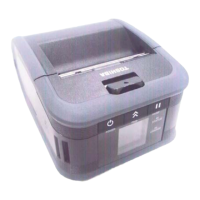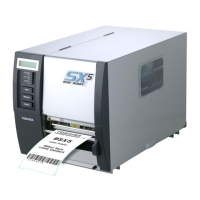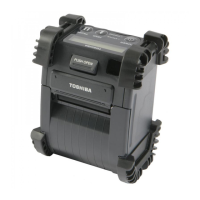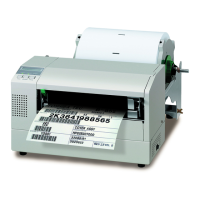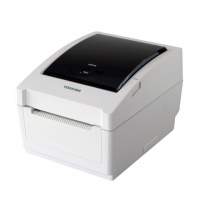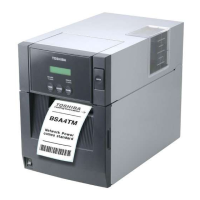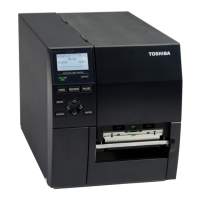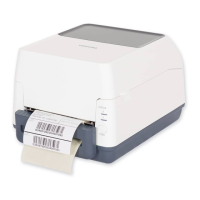
Do you have a question about the Toshiba B-FV4T-GS12-QM-R and is the answer not in the manual?
| Printer Type | Thermal Transfer / Direct Thermal |
|---|---|
| Print Resolution | 203 dpi (8 dots/mm) |
| Ribbon Width | Up to 110 mm |
| Ribbon Length | 300 m |
| Processor | 32-bit RISC |
| Flash Memory | 8 MB |
| SDRAM | 32 MB |
| Print Width | 104 mm |
| Media Width | 25.4 mm to 114 mm |
| Connectivity | USB, Serial, Ethernet |
| Memory | 8 MB Flash, 32 MB SDRAM |
| Operating Temperature | 5 to 40 °C |
| Media Thickness | 0.06 to 0.25 mm |
| Media Roll Diameter | 127 mm (5") |
| Supported Barcode Types | Code 39, Code 128, PDF417, QR Code |
| Power Supply | AC 100-240V, 50/60 Hz |
Warns that unauthorized modifications void user authority to operate equipment.
Information on product installation, usage, and compliance with radio frequency and safety standards.
Statement of compliance with EU directives for the B-FV4D series.
Details FCC compliance for Class A digital devices and potential interference issues.
Details FCC compliance conditions for device operation and potential interference.
Provides guidelines for safe installation and operation to meet RF exposure limits.
Statement of compliance with Canada's licence-exempt RSS standards.
Information on RF exposure limits and compliance for the wireless device.
Lists approved countries/regions and provides general precautions for device use.
Advice on managing Bluetooth interference and avoiding microwave disruption.
Discusses how installation location, orientation, and metal objects impact communication.
Details the printer's connectivity, operation, resolution, speed, capacity, memory, and accessories.
Lists and illustrates the items included in the printer package for verification.
Details the FEED button, LED 1, and LED 2 on the printer's front panel.
Details power, Ethernet, USB, and optional interface ports on the printer's rear.
Identifies ribbon supply/take-up wheels, media roll holders, and module release latch.
Identifies printhead, sensors, media guides, lock button, and platen roller.
Details LED blinking speeds and combinations indicating printer conditions.
Details the available commands within the system mode and their corresponding LED indicators.
Details how to connect the power adapter and AC power cord to the printer and wall socket.
Details the steps to power on the printer, including initial LED behavior.
Details the steps to power off the printer, including a warning about data transmission.
Instructions for preparing media rolls, distinguishing between inside and outside wound types.
Step-by-step guide for physically placing the media roll onto the printer holders.
Details guiding the media through the printhead and platten roller path.
Instructions for closing the printer module after media has been loaded.
Steps to test the media feed by pressing the FEED button and using the tear bar.
Describes non-continuous media, its characteristics and typical uses.
Describes continuous and fanfold media, their characteristics and uses.
Covers preparing ribbon rolls, installing supply and take-up rolls, and securing the ribbon.
Details the procedure for calibrating both transmissive and reflective media sensors.
Steps to print a configuration label for understanding printer settings.
Explains the printer's dump mode for debugging and viewing data in hexadecimal.
Details the steps required to perform a factory reset using the FEED button.
Describes the transmissive sensor, its placement, and how it detects gaps.
Describes the reflective sensor, its adjustability, and detection of marks or gaps.
Covers cleaning the printhead, media housing, sensors, and platen roller for optimal performance.
Details the procedure for locating, removing, and installing a new RTC battery.
Addresses issues like the printer not turning on or not feeding media correctly.
Solutions for poor print quality, ribbon errors, and media compatibility issues.
Solutions for USB memory errors, insufficient memory, cutter issues, and printhead problems.
Solutions for cutter problems, high printhead temperature, and printhead failure.
Covers model variations, print method, resolution, speed, media size, type, and ribbon specifications.
Details supported bar codes and specifications for USB, Ethernet, RS-232C, and Centronics interfaces.
Covers power supply, consumption, temperature, humidity, size, and weight.
Details the pinout and signal descriptions for Type A and Type B USB connectors.
Details pinouts for Ethernet, RS-232C, and Centronics interfaces.
Identifies compatible printers, lists kit components, and outlines the installation process.
Step-by-step instructions for physically installing the module, securing covers, and attaching labels.


